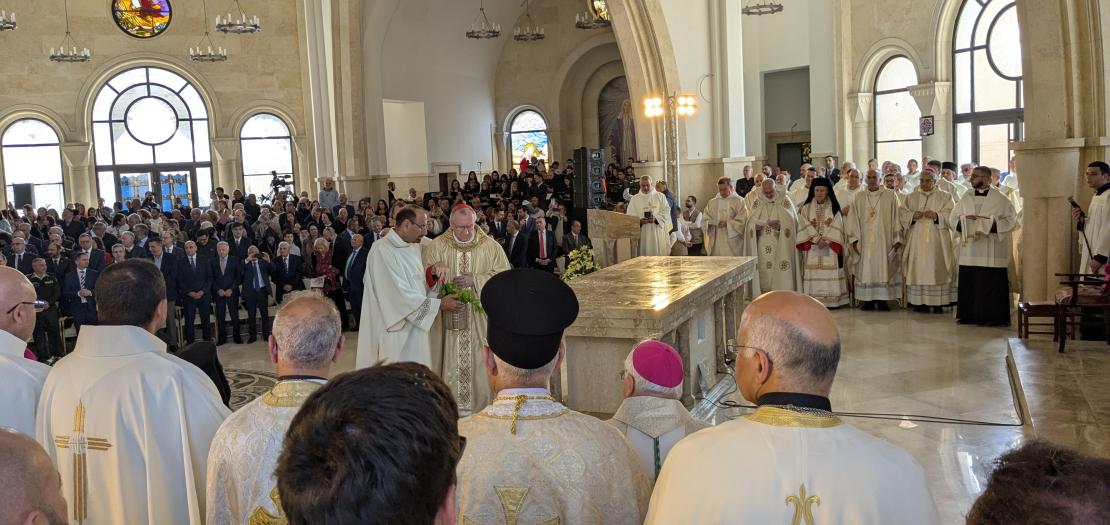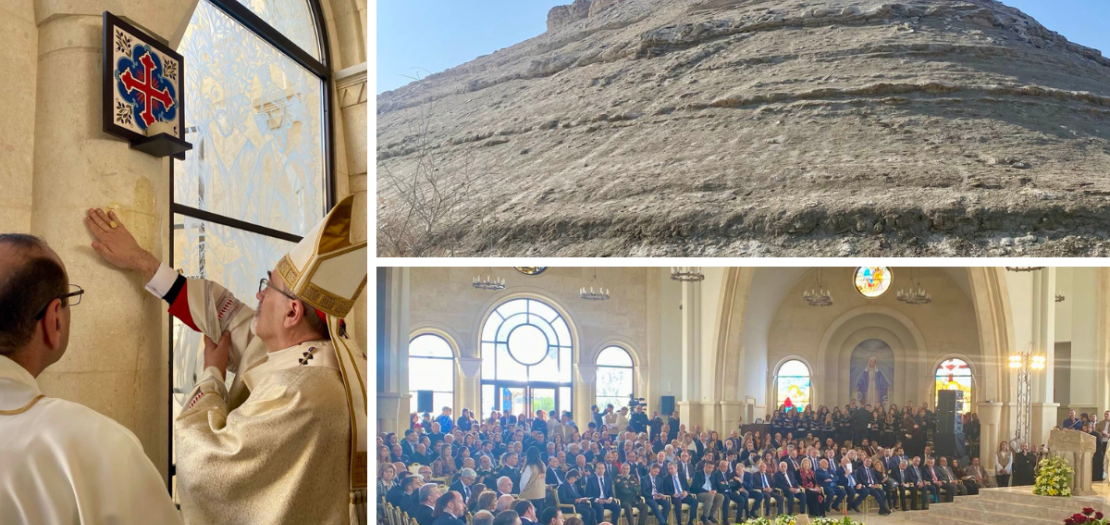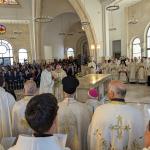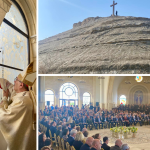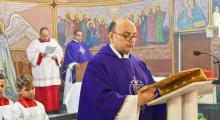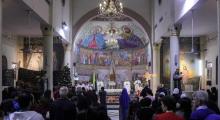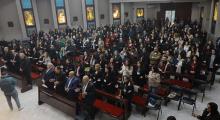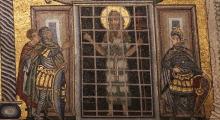Issued by the Catholic Center for Studies and Media - Jordan. Editor-in-chief Fr. Rif'at Bader - موقع أبونا abouna.org
The January 10 inauguration of a vast church on the very spot where Christ was baptized by St. John the Baptist in the Jordan River was an event of significant symbolic importance, both spiritually and diplomatically.
It also reflected the Hashemite Kingdom’s determination to establish itself as an essential stop-off point for pilgrims to the Holy Land, as well as a haven of peace for the world’s Christian faithful, who are increasingly reluctant to travel to a region torn apart by geopolitical and ethnic-religious conflicts.
“So many Biblical events and figures meet here that we could say that this place embraces the entire expectation of the Old Testament as directed to the coming of Christ, the manifestation of the Father,” said the Vatican’s secretary of state, Cardinal Pietro Parolin, at the ceremony of consecration of the altar on Friday morning, also attended by the patriarch of Jerusalem, Cardinal Pierbattista Pizzaballa, and Prince Ghazi bin Muhammad, son of Prince Muhammad bin Talal of Jordan.
Initiated following the King’s donation of a 30,000-square-meter (almost-7.5-acre) plot of land on the outskirts of the historic site of Al-Maghtas (also known as Bethany Beyond the Jordan, in the Qafra region) in 2003, the project was completed just in time for the silver jubilee of the grand annual pilgrimage, which for the past 25 years has taken place every January around the feast of the Baptism of Christ. This jubilee also coincides with the celebrations of the Catholic Church’s 2025 Jubilee.
One of the Largest Churches in the Middle East
The whole historic baptism site was identified and classified as a UNESCO World Heritage Site some 20 years ago. It has been since then the subject of extensive enhancement work carried out by the Jordanian authorities and transformed into a natural tourist park that is still in expansion.
Run by the Congregation of the Incarnate Word (IVE), the new Catholic church covers an area of around 2,200 square meters (almost 24,000 square feet) and is now one of the largest in the Middle East, alongside the Holy Sepulchre in Jerusalem and the Church of the Nativity in Bethlehem. It is the fruit of several years’ collaboration between the Latin Patriarchate of Jerusalem and Jordanian architect Nadim Muasher, a member of the Order of the Holy Sepulchre. It was Pope Benedict XVI who, during a visit to Jordan in 2009, laid the foundation stone for the building, alongside King Abdullah II.
The project, funded by the patriarchate and a number of charities, also benefited from a donation of almost 1 million euros from the Hungarian government through its “Hungary Helps” program, designed to support Christian communities in difficulty around the world.
The church was built of tafouhi, a yellowish stone from Hebron in the West Bank, while its stained-glass windows were made in Lebanon in a style intended to resemble that of the medieval Chartres Cathedral in France. The altar consecrated by Cardinal Parolin at the inaugural Mass houses the relics of Pope St. John Paul II and the Holy Martyrs of Damascus. The ceremony was attended by some 6,000 faithful, including around 1,000 inside the building — according to an estimate by the Jordan Tourism Board. Among them were around 100 priests and 15 bishops from several countries.
Renewing our baptism
Cardinal Parolin’s homily focused on the mystery of a God who chose to offer himself as a sacrifice for the salvation of mankind. Drawing an analogy with the fact that this Jordanian region is considered the lowest geographical point in the world, the cardinal pointed out that “it is precisely here that God came to meet us, as if to gather into his embrace also those from afar” and that “God’s providence has also seen to it that the Church we consecrate today shares the same axis as the Basilica of the Holy Sepulchre in Jerusalem.”
Recalling that baptism marks “the beginning of immortal life in us,” he also called for this place to become “a privileged place for all believers to renew their own baptism and their commitment,” especially during the Holy Year that has just begun.
In fact, the new church has also been designated as a place of pilgrimage for believers, who can receive a plenary indulgence during the 2025 celebrations that have the theme “Pilgrims of Hope.”
Closeness with Middle-Eastern Christians
Cardinal Parolin also stated that his presence at this symbolic event was intended to offer “a tangible sign of closeness” from the whole Church towards the Christian communities of the Middle East, especially in the context of the Israeli-Palestinian conflict that has been raging on the other side of the Jordan River since October 2023 and which has involved neighboring countries, especially Lebanon.
The fate of Christians in the region has been made even more uncertain by the recent fall of Bashar Assad’s regime in neighboring Syria to radical Islamic groups.
“I would like to encourage everyone not to be overwhelmed by the grave difficulties of the present time and to trust that God guides human history, however much it bears the scars of violence, sin and death,” said Cardinal Parolin.
Echoing his subsequent call for peace and the release of prisoners and hostages, Cardinal Pizzaballa urged prayer for “all those who suffer in their countries due to a lack of security, stability and peace,” stressing that Jordan was an exception in the region.
Efforts to preserve Christian heritage
This country with a strong Muslim majority (97per cent), which nevertheless boasts numerous biblical pilgrimage sites, has borne the brunt of the ongoing conflicts, seeing its tourist numbers drop by almost 70% over the past year.
“We dedicate this church to be at the service of Jordanian citizens in the first place and to serve the people of the Arab region who make pilgrimages to Jordan,” Cardinal Pizzaballa said during a press conference prior to the dedication Mass, adding that he also wanted to extend an invitation to other friendly countries. “Come, and do not be afraid,” he said. “Jordan is a safe and stable country.”
And to encourage the country’s Christians (2.1 per cent) — who have historically formed a socioeconomic elite — not to emigrate, and to persuade tourists from the Christian world, particularly the West, to visit, the Hashemite authorities have strongly engaged in a series of ambitious heritage restoration and enhancement projects. They hope these initiatives will make the kingdom an essential stopover for pilgrims to the Holy Land.
In an interview with the Register on the eve of the inauguration of the Baptism Church, Archbishop Giovanni Pietro Dal Toso, the apostolic nuncio to Jordan, praised the government's efforts to promote the Christian presence in the territory. He cited as an example the speed with which it approved a financing plan for the complete restoration of the archaeological site of Machaerus, the place of imprisonment and execution of St. John the Baptist, which had been left to decay for decades.
“Jordan is much to thank for the humanitarian aid and diplomatic mediation it has provided in recent years in the Israeli-Palestinian conflict, and this may have overshadowed other notable aspects,” he said.
He also sees in these lasting commitments a beneficial opportunity for rapprochement between this country, which plays a strategic role in the region, and the Christian world.
“This policy above all reveals and values what Jordan is and possesses,” he concluded, adding that it sounds like an effective reminder that “Christianity is not something foreign to the Arab world but is an integral part of it.”
This reminder is all the more crucial, in his view, as this re-rooting in a centuries-old history is the key guarantor of the region’s stability.


